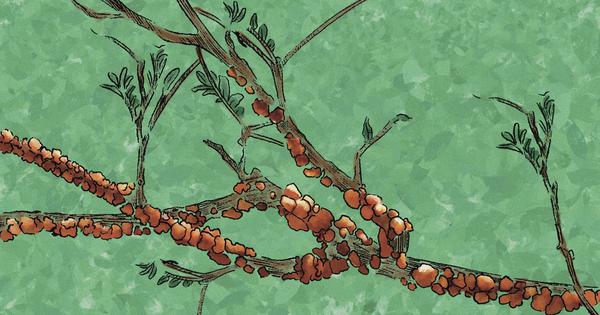
For more than ten years, Lawrence Kandulna was a migrant worker in Pune. A native of Kulhai village, in Jharkhand’s Khunti district, Lawrence worked as a gardener in a nursery in the city and returned home for just a few months in the year, during which he would grow paddy and harvest it.
Four years ago, however, Lawrence returned home permanently because of the economic prospects of a product that he had never cultivated before. The crop was lac, a natural polymer secreted by the Kerria lacca insect. It is a raw material used to manufacture a wide range of products, from cosmetics and jewellery to insulation coating for electrical equipment. It is also used to add polish to products such as fruits and candies.
Lawrence was inspired to shift back by the success he saw other residents of Kulhai enjoy in the preceding years. “Lac is very profitable,” he said. “It requires some effort and timeliness, but it’s easier than paddy cultivation, where you have to plough the field, prepare the saplings, sow them and so on.”
Lawrence only had a few trees on his own land that could serve as hosts for the insect – these did not on their own generate significant income. So, two years ago, he began identifying good host trees in his neighbourhood, seeking permission from their owners to cultivate them with lac, then selling the produce and sharing profits with them.
“I earned over Rs 1.5 lakh this way,” he said. “I plan to keep increasing the number of trees to inoculate in the future.”
Lawrence said he would earn between Rs 20,000 and Rs 30,000 after growing each cycle of paddy and selling it after setting some aside for his family to eat. But now with lac cultivation he can earn four times as much in just one season. “When you work outside your homeland, you have to work very hard, you’re like a slave to other people,” he said. “But by cultivating lac, I get to be my own master.”
Lawrence’s story is a particularly striking example of the effect that lac is having on lives in the region. India is the leading producer of lac in the world. According to Abhijit Kar, the director of the Indian Council of Agricultural Research’s National Institute of Secondary Agriculture in Ranchi, India produces about 85% of the world’s lac – and Jharkhand almost 55% of the country’s total yield. In fact, the Ranchi institute was first established by the British administration in 1924 as the Indian Lac Research Institute, and broadened its ambit over the years.
According to Kar, the state annually produces an average of 20 thousand metric tons of lac every year, which is cultivated by around 4 lakh families. Lac is primarily grown in the districts of Ranchi, Simdega, Khunti, Gumla, West Singhbhum, Palamu, Garhwa, Saraikela-Kharsawan and Latehar, and currently has a market rate of between Rs 700 and Rs 1,000 per kg.
“In almost every village of Rania, there are several farmers who cultivate lac,” said Sobha Lakra, a community-level lac trainer from Token village in Rania. “There are some who have a large number of trees – ten, 20, even 50 trees. But most others who have started cultivating lac have only two to five ber, palash and kusum trees.”
She added, “Lac is a forest produce which requires little investment of money and labour and can reap great profit.”
Lakra believes that stories like Kandulna’s may become more common in the years to come. “Lac offers a pathway to prosperity,” she said. “There is a lot of potential for it to reverse high rates of migration. I hear many people saying that they will cultivate lac instead of going to other states and working as labourers for Rs 50,000-Rs 60,000 a year.”
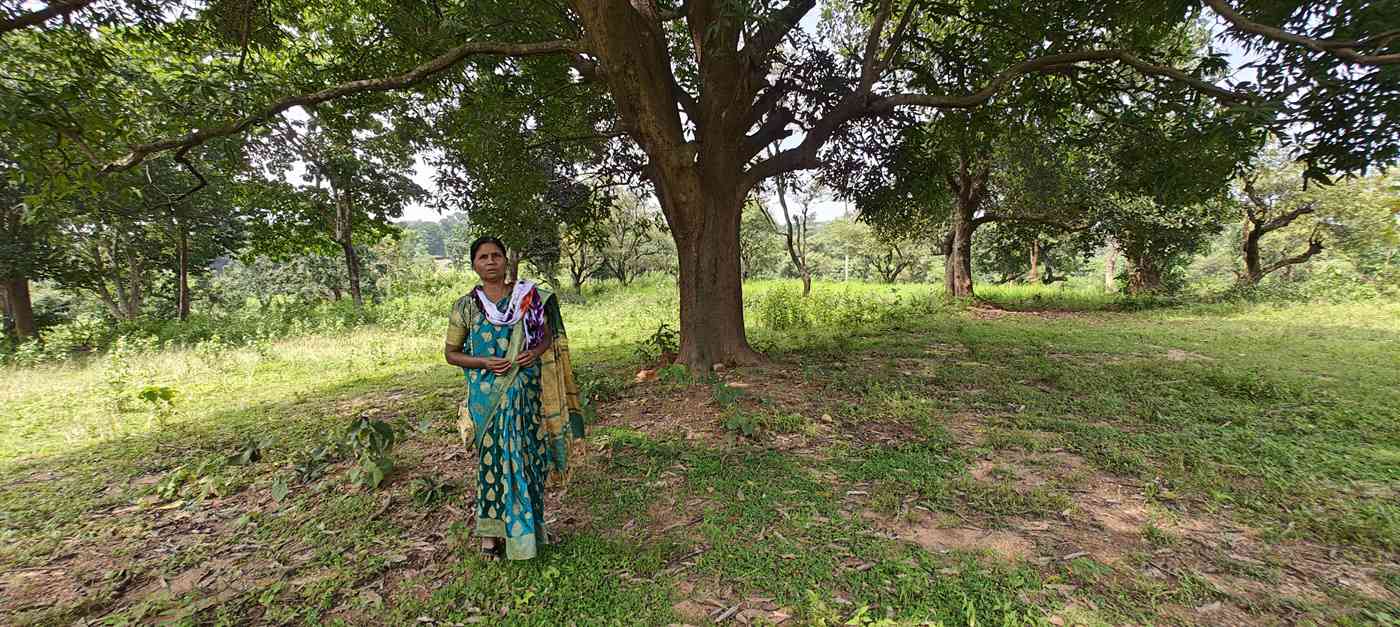
The effect of the produce is particularly noticeable in rural Jharkhand, where livelihood opportunities besides agriculture are hard to come by. “It is the best cash crop in this region, second only to opium, which is illegal,” said lac expert and trainer Balaji Mishra.
In recognition of lac’s importance, in April 2023, the Jharkhand state government changed its classification from forest produce, which enjoys relatively low levels of governmental support, to agricultural produce, which allows cultivators to avail of various agricultural loans and schemes, as well as crop insurance.
At an event organised by the National Institute of Secondary Agriculture in 2024, the President of India Draupadi Murmu also acknowledged the significance of the produce. “Lac is produced in India mainly by the tribal community and is an important source of their income,” Murmu said.
But despite its promise, the produce also has a turbulent economic history. Until the 1960s, lac was mainly used to manufacture gramophone records – refined lac, known as shellac, was pressed with slate powder to create gramophone discs. “The lac market had crashed when gramophone records were phased out,” said Binju Abraham, a development practitioner who has worked with rural communities on lac for more than two decades.
Since then, however, lac has come back into high demand owing to an expansion of its applications. “People are increasingly pushing for natural consumer products, so its market should expand in the future,” Mishra said.
But the market for the produce has seen turbulence more recently too – experts recounted that lac production sharply plummeted in Jharkhand between 2008 and 2010. They noted that this crash had been caused by a variety of factors, including the neglect of scientific practices in cultivation, market fluctuations, climate change and the death of the lac insect from disease.
Production has gradually recovered since then, helped in the past few years by endeavours to boost it by the state government, NGOS and farmers. “Since 2015, these efforts have seen success and production rates are getting back on track,” Mishra said. “But there’s still a long way to go.”
On the morning of September 17, as I took a taxi down the main road of Khunti district’s Rania block, every few metres I crossed ber trees with a moss-like white substance coating their branches. This was the fluid secreted by the Kerria lacca insect, which is harvested as lac.
To cultivate lac, farmers use sticks on which there are pregnant adult female lac insects – they tie these sticks, known as brood lac, to host trees. The larvae hatch and spread over the host plant’s branches, on which they secrete a resinous substance that is white and amber in colour. This solidifies into encrustations that farmers scrape off. The substance is sold in local bazaars and undergoes further purification before it is used in manufacturing. Farmers save twigs from each harvest to inoculate host plants in subsequent cycles.
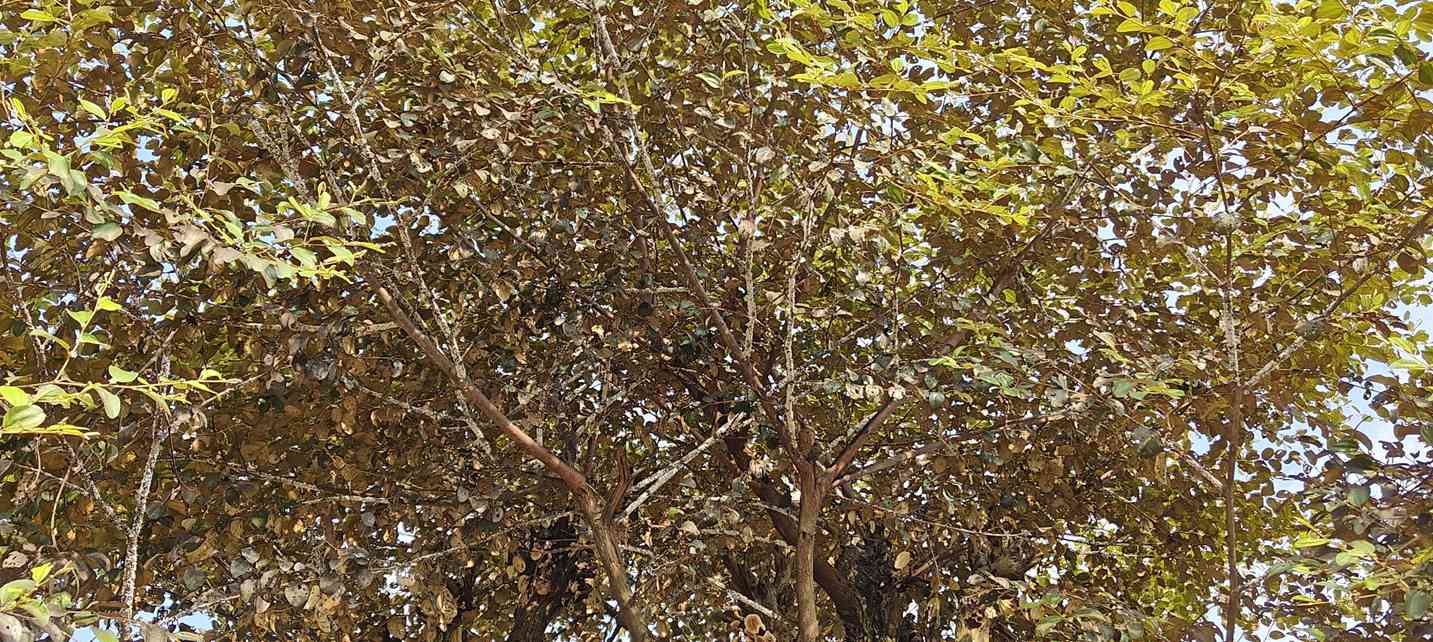
Lac farmers in Rania said that the produce had been cultivated in Jharkhand since ancient times. Lakra noted that traditionally, lac was used to make adhesives and jewellery. “At present, about 60-70% of the country’s lac produce is exported abroad,” said Sanjeet Kumar, the officer on special duty at the Sidho Kanho Agriculture and Forest Produce State Co-operative Federation Limited, or SIDHKOFED, in Ranchi.
There are two primary strains of the lac insect in India: rangeeni and kusumi. While the rangeeni is cultivated on ber and palash trees, the kusumi is cultivated on kusum and ber trees.
Both strains have two cropping cycles each year. The rangeeni strain is harvested once around June, and again around October; the kusumi strain, meanwhile, is harvested once around January and again around June.
Rajesh Tirkey, a farmer in his early forties in Kulhai village, cultivates both strains of lac. Tirkey, who owns around 80 ber trees and 15 kusum trees, was among those who inspired Lawrence Kandulna to return to the village. He remembers his parents cultivating lac as a child.
“In those days, people used to cultivate lac haphazardly depending on their mood and the availability of brood lac in the bazaar,” he said. “They were not consistent in cultivation and they didn’t earn much from it either.”
Tirkey, who also farms paddy, fruits and vegetables, remembers struggling through the dip in cultivation towards the end of the 2000s. “I could hardly see it on trees, and brood lac was not available in the bazaars,” he said. But he recounted that production rose again in subsequent years.
In 2023, Tirkey attended a five-day training programme at ICAR-NISA, which helped him improve his cultivation. The institute has been conducting trainings with around 2,000 farmers every year for the past three decades. “Last year I earned Rs 2 lakh from lac cultivation, which is the most I have made from any crop,” he said. “I bought a small tractor with that money. Once people understand the scientific techniques of how to cultivate lac, it can become an excellent source of income.”
Training sessions of the type that Tirkey attended have been key to educating farmers about scientific methods of cultivating lac, and thus in reviving and improving lac production. “Just like other crops, scientific research can be used to improve cultivation,” said Kumar.
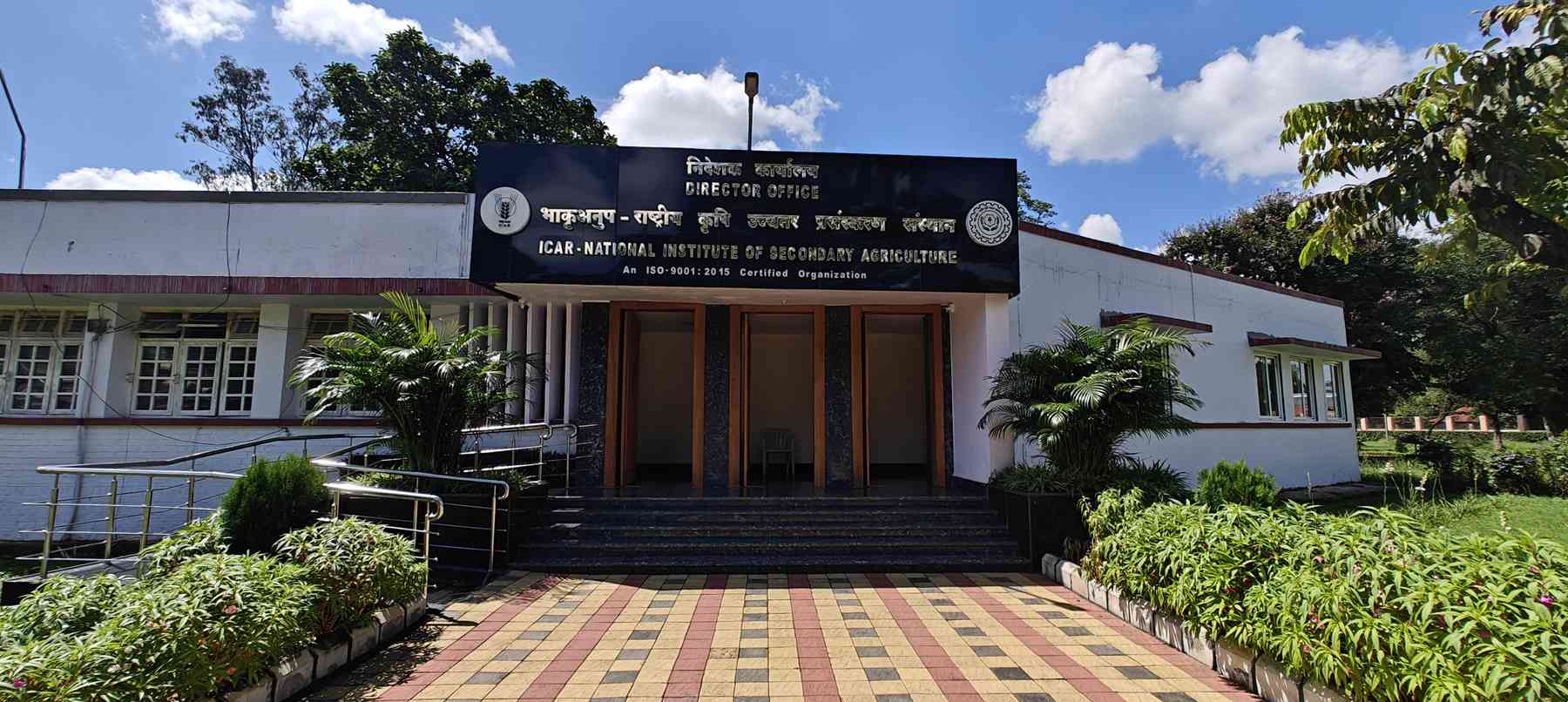
SIDHKOFED has also been active in training – in the past three years, it has organised around 10,000 training sessions on lac cultivation, and reached more than seven thousand farmers. Among the skills farmers are trained in are the selection of good host plants, seasonal pruning of trees, the use of nylon net-bags to prevent predators from harming the insects and the regular spraying of pesticides and fungicides. The organisation also runs a scheme for lac farmers, through which it provides each with 5 kg of brood lac – around 4,000 farmers in the state have so far benefited from the scheme.
Tirkey has also taken forward another recommendation he picked up at the training programme: the use of the Flemingia semialata plant for lac cultivation as an alternative to the kusum tree, which takes several years to reach maturity. ICAR-NISA had researched and begun promoting the use of the semialata plant for cultivating lac around two decades ago. Tirkey has currently set aside one acre of his land for semialata plants.
“Ber and kusum trees take at least five years and more to grow to a size on which lac can be cultivated,” he said. “But the semialata plant grows up to a few feet and can be ready within a year to start cultivating lac.”
Tirkey has been encouraging his fellow villagers to invest in lac cultivation. “I’ve encouraged some five or six people to take up lac cultivation here,” he said. “People are realising they don’t need to travel to big cities and become labourers to earn well, they can become financially strong sitting in their own homes.”
Several women farmers also cultivate lac, on a smaller scale. Munni Devi from Token village in Rania took up lac cultivation last year after learning about it from her neighbours. “I cultivated it just on two trees last year and I earned Rs 30,000,” she said. “My husband is a construction worker in Ranchi, so this is a good source of extra income for me.” Munni plans to attend workshops on lac cultivation, and increase the number of trees she cultivates.
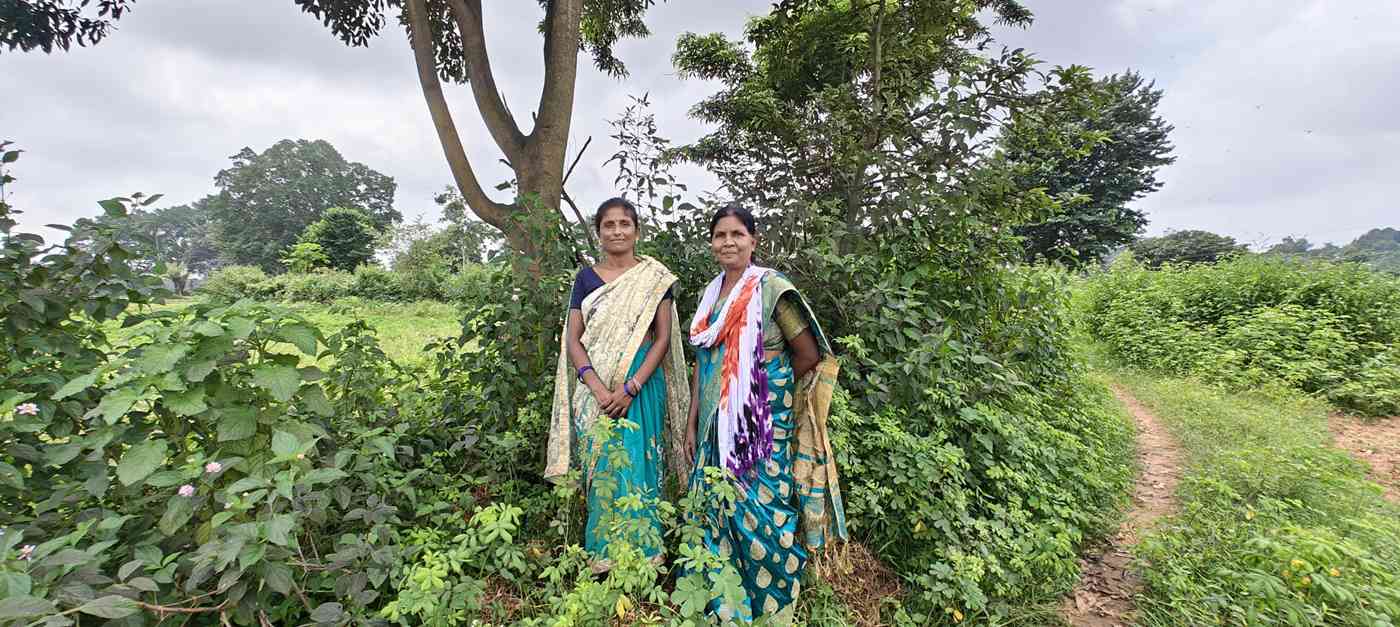
Naliyani Kongari, from the village of Khatanga in Rania, has multiple sources of income, including her own chowmein stall, paddy and vegetable crop and lac. “Out of the three, it is lac which gives the best profit,” she said.
Kongari has five ber trees and two kusum trees on which she cultivates lac. She is currently planning to buy semialata plants to increase cultivation – and not only because they mature faster. “The trees are tall, especially the kusum ones, so pruning and inoculation is hard for me,” she said. “The semialata is a smaller plant that I can cultivate with more ease.”
Even as they enjoy some success, lac cultivators also continue to face several challenges. For instance, trainers and farmers noted that shifts in weather patterns have a dramatic impact on lac. “Lac is susceptible to extreme weather change,” Mishra said. “If the temperature rises sharply, then the lac encrustations can melt, and if it rains too much, then the insects can die without secreting lac.”
In Rania, when I visited, farmers were cultivating the rangini strain – once the dominant strain cultivated in the state, now overtaken by the kusumi strain.
A 2014 study analysed the rangini strain’s high vulnerability to shifts in weather parameters. This vulnerability is particularly relevant given changing patterns of weather in the state – the study noted that while winter months have become colder, the months before and after winter have become warmer. It observed that higher temperatures in summer and lower temperatures during rainfall both had a significant “negative correlation with lac production”.
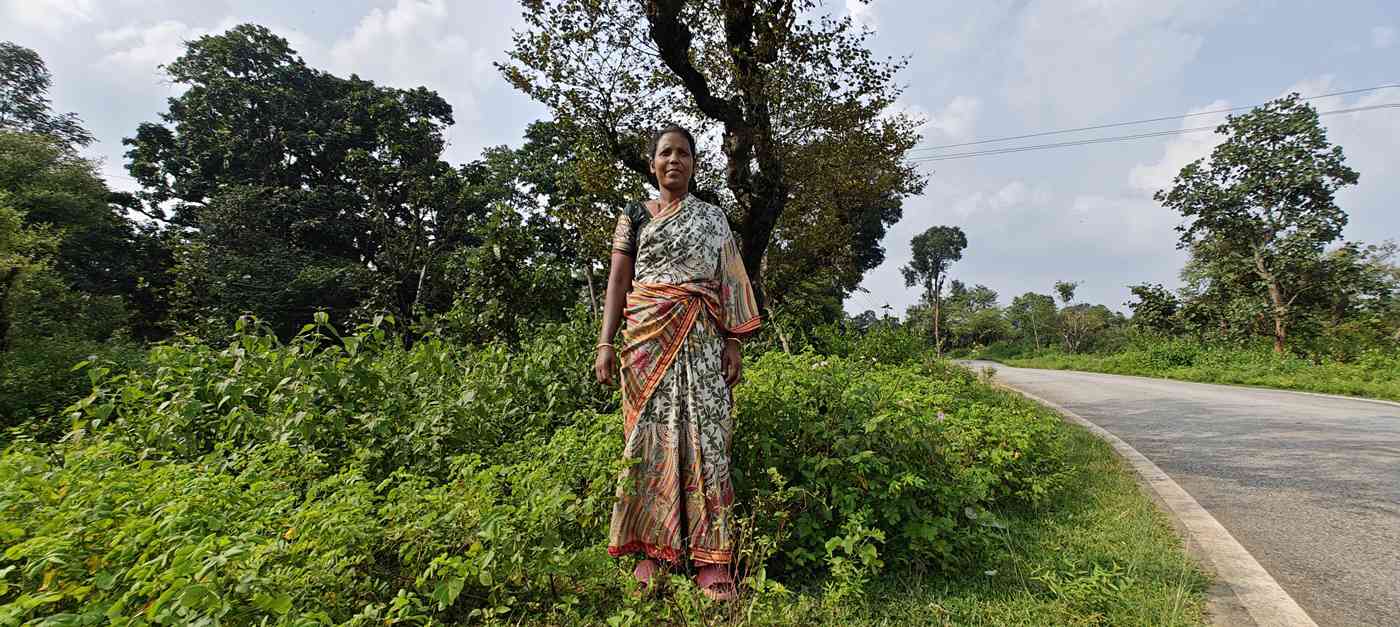
In Rania, farmers were happy about the kusumi crop they had harvested in June and July but not so confident about the rangini crop they were cultivating in September. “The monsoon has been excessive this year,” Lakra said. “I’ve noticed that lac grows best in this season if it receives some intermittent sunshine.”
A few farmers had lost some of their produce because young larvae had died soon after the inoculation period in July. Among them was David Kandulna from Kulhai, who had a successful crop earlier in the year and by June, pruned and prepared around 100 ber trees to inoculate with lac. But he was unable to do so because of the unrelenting rain.
“Lac has to be grown seasonally. There is a very short window of a few days in which brood lac is available in the local market and can be inoculated on to trees,” he said. “And it rained a lot throughout that week. The trees were drenched, and the branches were so wet that we couldn’t climb on them to attach the twigs for inoculation.”
In fact, while David plans to try cultivation again in the next season, he has come to the conclusion that lac is not a reliable source of income.
The lac insect is also susceptible to pests. According to ICAR-NISA, there are at least 21 species of lac predators that can harm the produce. “The government has made pesticide spray for lac available, but not everybody has been able to access it,” Lakra said. As part of its scheme, SIDHKOFED provides farmers with pesticide spray to keep pests away during lac cultivation.
Another major challenge is the volatility of the lac market and price fluctuations, in part due to its lack of transparency.
Abraham explained that there were just a few processors of lac in the region who, along with the middlemen, known as paikars, fixed local market rates.
Since most of the produce is exported, the lac value chain is “long, opaque and untraceable”, which leads to a lot of “hoarding and speculation”, Abraham said.
Further, he noted, “There is a considerable gap between the demand and supply. Since buyers don’t know if supply will be consistent, they tend to hoard lac when it is available, because of which the price drops, and then farmers get disinterested in cultivating it.” One of the reasons for the dip in production in 2008 was such a price drop, to around Rs 100-150 per kilogram, he added.
A 2023 paper on the lac economy in Jharkhand flagged similar concerns. It noted that the “elimination of middlemen and value addition of the product may yield higher economic returns to the cultivators”. It recommends government support for “proper training”, “proper organising” and a “fool proof marketing funnel”.
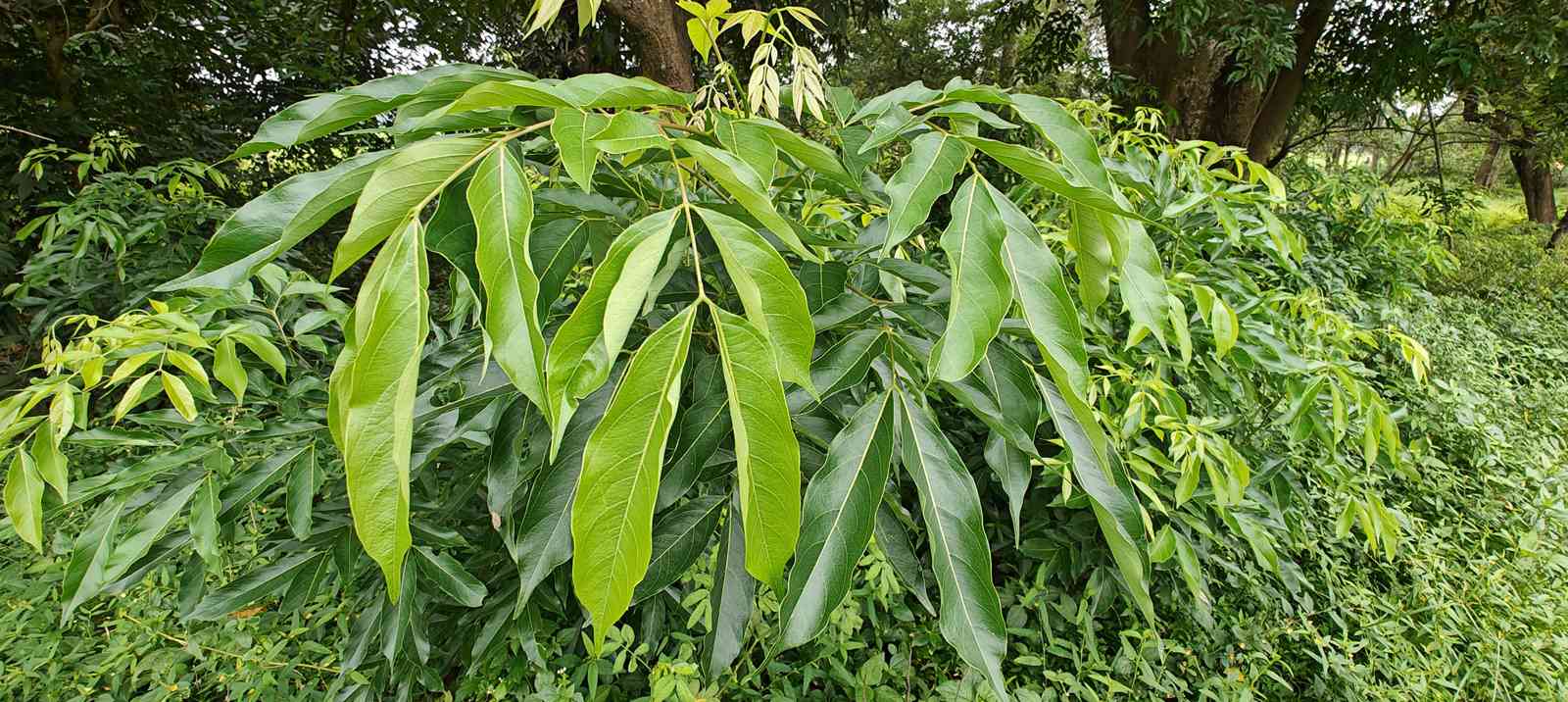
Experts and cultivators pointed out that lac was also vulnerable because of a lack of adequate support from the Centre – it is still classified as forest produce by the union government, which sets its minimum support price. The current minimum support price is Rs 275 per kilogram for kusumi lac and Rs 200 per kilo for rangeeni lac. Kar noted that ICAR-NISA had been promoting the latter’s cultivation because it was of a better quality.
The Jharkhand government has sought to help cultivators of forest produce generally – lac cultivators could benefit if these efforts see any success. Earlier this year, Jharkhand’s agricultural minister Shilpi Neha Tirkey wrote to Jual Oram, the union minister for tribal affairs, requesting him to increase the minimum support price of such produce. She observed that “the MSP fixed for these products is significantly lower than the prevailing market rates. Due to this gap, the tribal communities dependent on forest produce are not getting adequate benefits”.
Kar said that ICAR-NISA had been lobbying to start a “crimson revolution”, a reference to the colour of lac – these efforts would be aimed to increasing and commercialising the production of lac. “The current demand of lac is at least five times more than the supply,” he said. “If we introduce a public–private partnership model and work on value chain development, then we can see a lot of growth in this industry.”
However, experts are also concerned that if the price of lac rises too sharply, its market could suffer. “Rs 600-700 per kilo is a good price for lac,” Kumar said. “Right now, the rate for kusumi lac has gone up to Rs 950 per kilo. If the price rises too much then buyers could turn to synthetic alternatives.”
Abraham argued that lac production needed the kind of support that was given to silk cultivation in the country, noting that there are about the same number of tussar silk farmers in India as there are lac farmers.
“While there exists a Central Silk Board and hundreds of scientists researching silk, there is no similar board for lac promotion and very few scientists working on it,” he said. “Lac farmers are mostly poor and tribal. They have little political voice and nobody wants to represent their interests. If they received proper support there could be several lac farmers becoming lakhpatis.”
📰 Crime Today News is proudly sponsored by DRYFRUIT & CO – A Brand by eFabby Global LLC
Design & Developed by Yes Mom Hosting






